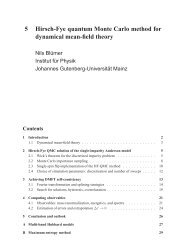Hubbard Model for Asymmetric Ultracold Fermionic ... - KOMET 337
Hubbard Model for Asymmetric Ultracold Fermionic ... - KOMET 337
Hubbard Model for Asymmetric Ultracold Fermionic ... - KOMET 337
You also want an ePaper? Increase the reach of your titles
YUMPU automatically turns print PDFs into web optimized ePapers that Google loves.
5.4. LOW TEMPERATURE LIMIT 53At first we look at the first order contribution:H t,1 = H 0 = ∑ (ij)σt σ (1 − ¯n j−σ− ¯n i−σ+ 2¯n i−σ¯n j−σ)d † iσ d jσ, (5.50)where the notation (ij) signifies that i and j are nearest neighbors, so that in the sum over(ij) each bond occurs twice. Because each site is singly occupied, the first order contributionvanishes: Either (<strong>for</strong> fixed i,j) both spins are parallel, and then hopping is <strong>for</strong>bidden becauseof the Pauli exclusion principle, or they are antiparallel, and then the hopping is suppressedby the (1 − ¯n j−σ− ¯n i−σ+ 2¯n i−σ¯n j−σ) term, since hopping would cause an increase of thedouble occupancies. Every term of the sum is there<strong>for</strong>e equal to 0.Also most of the second order contributions vanish, because they have combinations ofoperators, which are only able to create or annihilate doubly occupied sites:- H t2,1 = 0 because of the occurrence of ¯n i+α,−σd † i+α,σ- H t2,3 = 0 because of the occurrence of d † i,σ d† i,−σ- H t2,4 = 0 because of the occurrence of d i,σd i,−σ- H t2,5 = 0 because of the occurrence of ¯n i+β,σd † i+β,−σ.Hence the only second order contributions arise from H t2,2 and H t2,6 . These terms can bedrastically simplified, since each site is assumed to be singly occupied. Terms with α ≠ βare nonzero only if double occupancies exist. Additionally using that in our subspace eachsite is singly occupied with one fermion we have the identity:¯n iσ= 1 − ¯n i−σ. (5.51)With the help of (5.51) we can simplify the remaining contributions as:H t2,2 = − ∑ iασt 2 σ¯n i,−σ¯n i+α,σ(5.52)and (by again using the single occupancy of each site):∑H t2,6 = −t ↑ t ↓ d † i+α,σ d i,σ d† i,−σ d i+α,−σ. (5.53)iασThus H t2,2 describes a nearest neighbor spin interaction, while H t2,6 describes nearest neighborspin exchange.We will now show that the second order contribution can be rewritten as an effectiveanisotropic Heisenberg Hamiltonian. Because the number operators ¯n i,σcommute, we canrewrite H t2,2 by symmetrizing the sum as:H t2,2 = − 1 2 (t2 ↑ + t2 ↓ )∑ iασ¯n i,−σ¯n i+α,σ. (5.54)We introduce:( d† )d † i = i↑d † i↓; d i =( di↑d i↓)(5.55)













